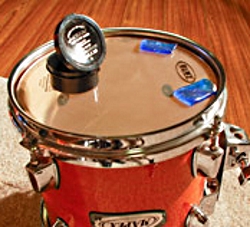What Is Damping?
Damping (or dampening if that’s how you roll) is controlling the decay and overtones of a drum. Damping the drum is NOT a way to deal with a poorly tuned drum.
Knowing how to effectively control the sound of the drums through damping is essential for every drummer, producer and recording engineer.
Here I’ll cover some inexpensive products, some do-it-yourself options, and then some kick drum specific methods. This article is dealing with recording live drums, not damping and muffling for practicing.
Commercial Products
Moongels—These are great inexpensive, reusable jelly pads that stick to the top head of the drum to control the ringing.
Super simple to apply. I like these a lot. Two sets should last you for years. These work best on the top head of a snare or tom and fall off the bottom.
O Rings/E-Rings—These are my favorite method of damping toms. They’re thin clear plastic rings that sit on top of the drum head. I love the instant gratification they provide.
On snare it’s not always my favorite sound, and can get in the way for brush work. They’re also inexpensive and should last a long time unless they get folded or bent.
Do It Yourself Options
Gaffer tape or masking/painter’s tape—NEVER use duct tape or electrical tape on drums, it’s just gross. Gaffer (Gaffa), masking tape or painters tape will apply and remove cleanly from the drum.
There are a couple techniques for using tape to damp. Try making a loop of gaffer tape sticky side out, stick it about an inch from the rim. With masking or painters tape take a 4-inch strip folded so there is a small “handle” for easy removal.
I’ll tend to use tape on the bottom of toms if E-Rings aren’t enough. You can also use tape on cymbals if they’re too ringy/washy.
Reused O-ring made from an old drum head—Next time you change your drum heads, cut them into O-Rings. Cut off the outer edge and the center. This costs nothing just some time.
Cotton balls – I once heard of putting a few cotton balls inside a tom to very naturally reduce the sustain time of the drum. Sounds like a good trick but I haven’t yet tried it.
Kick Drum Specifics
Pre-damped heads – There are a wide variety of drum heads available with damping built-in.
One of the most common is the Evans EMAD 2 which is a normal drum head with a plastic ring and foam damping insert. I really like the sound of these heads. Aquarian and Remo also have nice pre-damped heads.
Inside the kick – From pillows to more advanced systems, there are a lot of options inside the kick drum.
IMO all kick drums should have some kind of damping to sound good. You can take a blanket, fold it and place it inside so its just touching the batter head. Place something heavy like a sandbag or cement block on top so it doesn’t slide away during the performance.
I’ve read that some people will partially fill their kick with shredded newspaper but that seems really silly to me. A chunk of acoustic foam will work nicely as well.
Jon Tidey is a Producer / Engineer who runs his own studio, EPIC Sounds, and enjoys writing about audio on his blog AudioGeekZine.com. To comment and ask questions about this article go here.





















